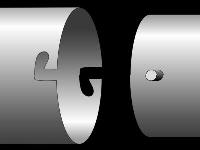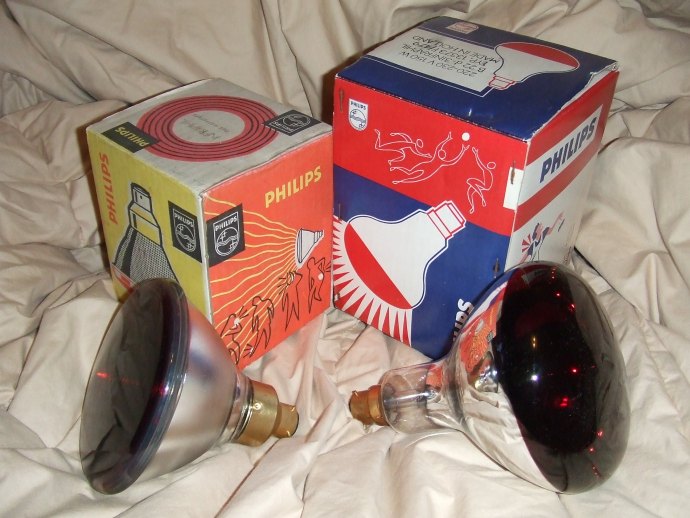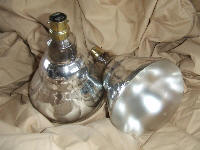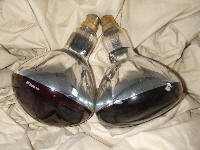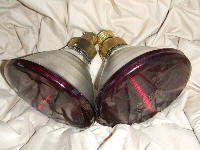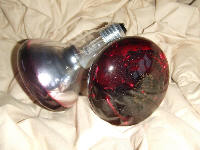Philips Infraphil 1945 - 2014

does not influence the yield of infrared radiation but it restrains the bright visual light, preventing the need for protective glasses. The early "white" Infraphil lamps can easily be confused with blended lamps that have been merchandised in the same era and partly even in the same type of armatures. Blended lamps however, are no heat lamps but ultraviolet- or sun-lamps. From around 1950 the Infraphil lamps carry the type number 13373F/479, independent of the armature they are sold in. Some years later the front of the glass bulb becomes more flattened than before. This version of the lamp is produced until about 1965 and it exists with three types of print on the front. The oldest
print with the Infraphil logo as used on the early lamps (type A), a later print with a circular text without logo or wordmark (type B) and finally a print with three Philips shield emblems in a circular configuration (type C). From around 1962 the production code consists of a combination of a single character and a one-digit number.
© copyright 2005-2020 - infraphil.info
v3.18.1
1960 - 1980, pressed glass lamps with bayonet mount
Around 1960 Philips introduces a completely new type of Infraphil lamp with type number 13379F/479. This lamp is made from pressed glass, making it less vulnerable. The front of the lamp has a so-called Fresnel lens, improving the convergence of the radiation. The pressed glass lamps with type number 13379F/479 are, like their blown predecessors, equipped with a bayonet mount and carry the same variations of prints on their front.
13379F
1981 - 2010, lamps with screw mount
Around 1980 the pressed glass lamp 13379F is replaced by a modernised version, the PAR38F. A few years later the bayonet sockets of the Infraphil armatures are replaced by
PAR38E
E27 screw sockets, than common for normal incandescent lamps. The E stands for Edison, the original inventor of the system, and 27 is the diameter of the screw in millimeters. The corresponding Infraphil lamp is the PAR38E. The print on the PAR-lamps is of the type C version with the three
Philips shield emblems, the operation voltage, the power dissipation (150W), the type number, a production code, the country of origin and both the trademark Philips and brand name Infraphil. There are PAR38E lamps where the brand name Infraphil is replaced by the code IR but these are heat lamps for general purposes. PAR38E lamps without
Around 1985 Philips introduces a low-cost Infraphil lamp. It is a small blown lamp with type number R95E and a dissipation of 100 Watt. The print on the lamp consists of a single Philips shield emblem, surrounded by the operation voltage, the power dissipation, the type number, the land or region (E.C.) of origin the trademark Philips and the brand name Infraphil. The lamp is equipped with a reflector but it has no Fresnel lens. Since 2008 the brand name Infraphil is no longer printed on the lamps.
reflector and Fresnel lens also exists but these are for lighting purposes only and not appropriate for medical heating appliances.
Infraphil lamps
Infraphil lamps are designed for medical applications and differ from infrared lamps for paint curing or other applications. Infraphil lamps are dimensioned for a maximum yield of short waved infrared radiation that penetrates relatively deep into the human skin. More specific information about the characteristics and applications of infrared radiation for medical treatment can be found at helivium.com. From 1946 on, Philips has produced Infraphil lamps in various versions. Below you can find the major properties that distinguish these versions from each other.
Infraphil lamps
1946 - 1965, blown lamps with bayonet mount
The oldest Infraphil lamps are made of blown glass and the base of these lamps is connected to the socket in the armature by means of a so-called bayonet mount. Two electrical contacts are located at the bottom of an isolator that fits into the metal base of the lamp. There are two pins that sideways protrude the metal base. These pins fit into two corresponding sleeves in the socket. The lamp is gently pressed against a spring-loaded construction in the socket and is than hooked into it by a slight turn of the lamp. The bayonet mount of the Infraphil lamps has three pins that are mounted at an unequal mutual distance, causing the base of the lamp to fit in the socket in one position only.
13373F
Philips Infraphil lamps
The leading part of the type number of early Infraphil lamps equals that of the type number of the armatures they came in. The type number is printed on the front of the lamp, together with the
operation voltage, the power dissipation (always 150W), a production code, the country of origin, the Philips trademark and an Infraphil logo consisting of a rectangle with rounded corners with the brand name infraphil in it. On the first letter i of infraphil is an eight-pointed star that partly sticks out of the rectangle. The production code is formed from a combination of small points and stripes in a fixed configuration. The oldest Infraphil lamps with type number 7525 lack an infrared filter. It's successor with type number 7526 has an infrared filter and in the documentation it is referred to as "the red Infraphil". Like all Infraphil lamps, both types are equipped with an internal reflector. The filter
bayonet socket lamp base
